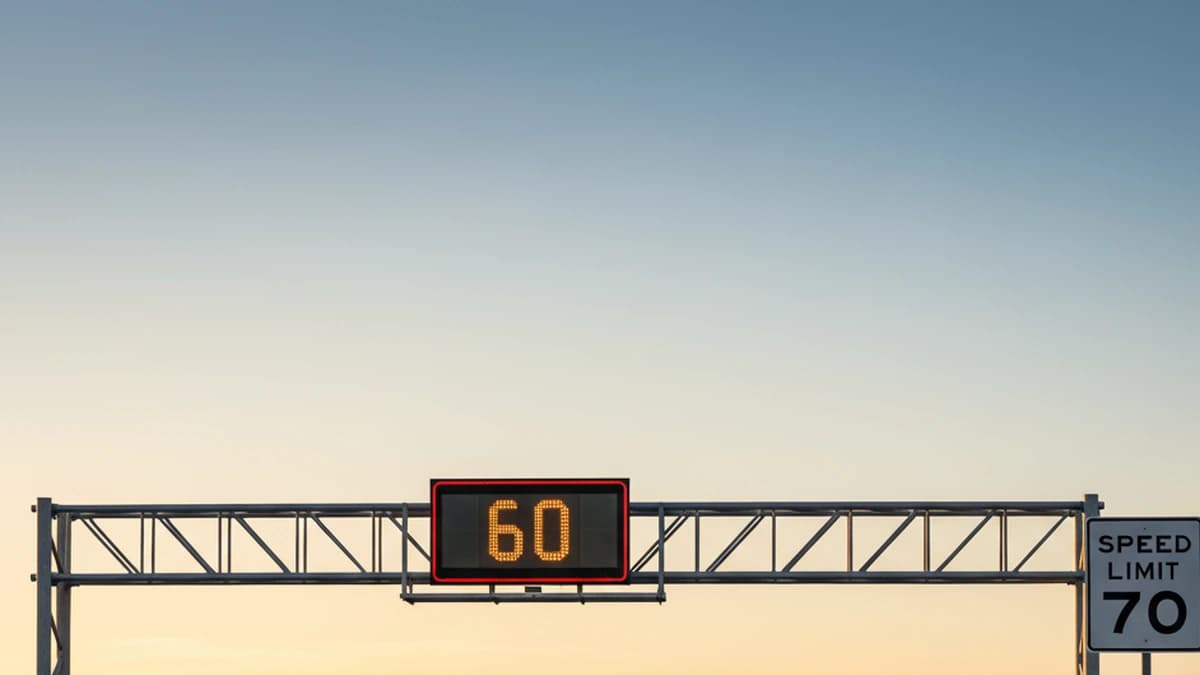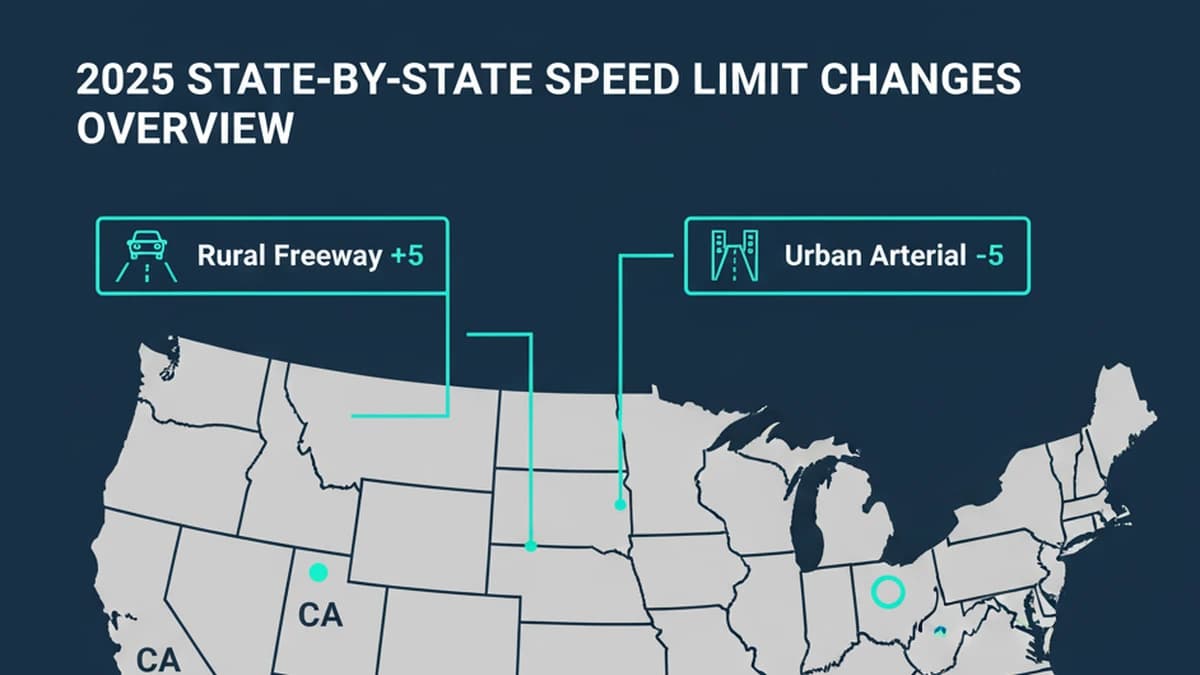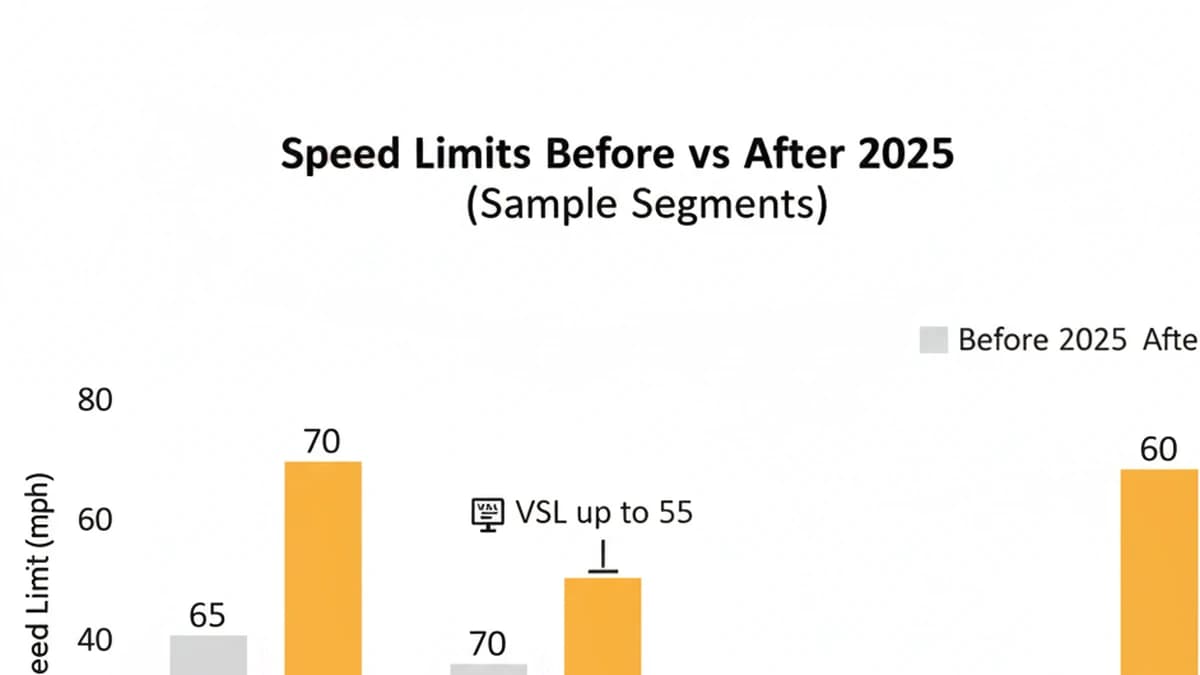State-by-State Speed Limit Changes in 2025
Published · 10 min read · Verified explainer with diagrams and links to official sources.

This guide breaks down state-by-state speed limit changes in 2025 and explains how those updates interact with posted signs, variable speed limits (VSL), work zones, and school zones. The headline number—say, 70 or 75—often grabs attention, but the real rules live at the curb: the sign in front of you, optional plaques below it, and electronic displays that can change by time of day, weather, or traffic. We also link you to state pages for deeper reading: see California Laws, Texas Laws, New York Laws, and Florida Laws. If you are refreshing fundamentals, our primers—Driving Rules, Rules of the Road, and Road Markings—are a fast way to orient before a road trip.
What changed in 2025 and why posted signs still control
In 2025, several states adjusted maximum rural freeway limits on specific corridors, while metro areas fine-tuned urban arterial limits to balance throughput and safety for people walking, biking, or taking transit. Some states expanded VSL programs on busy interstates or mountain passes, and others clarified school-zone windows so drivers understand when the lower number applies. Regardless of the statute text or press release, the posted sign in the field is the enforceable rule. If a portable message sign, lane-control signal, or work-zone sign shows a lower number, that lower number governs for that segment.

Engineering, enforcement, and safety corridors
Speed limits are not plucked from the air—they come from engineering studies, crash data, and land-use context. States increasingly designate safety corridorswhere fines are higher and the limit can drop below the general rule. In work zones, expect doubled fines and strict speed photo enforcement where authorized. Before a cross-country drive, check our posts on right turn on red and school bus stop laws—two topics that often interact with corridor speed choices.
Advisory speed vs. enforceable limit
Yellow advisory plates (e.g., for curves or ramps) show a recommended speed based on comfort and operating conditions; the white SPEED LIMIT sign is enforceable law. Treat advisory numbers as a floor for caution in bad weather.
When signs differ from statute
Statutes establish ceiling values and default rules, but agencies can post lower (or higher within the legal ceiling) after studies. If the sign says 55 where you expected 65, the 55 is the law until you pass a sign that changes it.
Example citation wording
Many citations read like: "Driver operated a motor vehicle at 68 mph in a posted 55 mph zone, contrary to the posted sign." Note the emphasis on posted.
State-by-state snapshots: where 2025 speed limits shifted
Below are concise snapshots for the states most readers ask about. These are not exhaustive; they are a map for what to look for on the road and where to verify specifics on the state page.
California 2025: context-driven limits and safety zones
Rural freeways and expressways
Rural interstates largely hold steady, but select desert and valley segments saw targeted adjustments where geometry and crash data supported modest increases. Where terrain tightens or wildlife crossings concentrate, you may see lowered night-time limits or active VSL.
Urban arterials and school areas
Expect refined limits on vision-zero corridors and near campuses. In marked school zones with flashing beacons, the lower value applies only when beacons flash or within the posted times. Review our guide on pedestrian right-of-way to avoid the most common tickets.
Left-turns, signals, and context
Speed and turns are linked. See left on red for one-way intersections and the double-double yellow painted median rules before you plan U-turns.
85th-percentile note
Many updates reference the 85th percentile speed from spot studies—one reason you might see a limit change without a major construction project.
Texas 2025: long rural runs and expanding VSL
Rural freeway maximums
Texas continues to post high limits on long, straight rural segments. Where 2025 changes appear, they are typically segment-specific and backed by studies of sight distance and crash patterns.
Urban & suburban arterials
Growth corridors near metros adopted more context-sensitive limits and dynamic VSL during peak congestion or storms. When the electronic sign is active, it controls—even if the static plate nearby shows a higher number.
Construction zones
Texas work zones often feature prominent orange plates and strict patrol presence. Expect enhanced penalties when workers are present, similar to other states.
Practical tip
If a portable sign displays 55 in a corridor you know as 70, treat 55 as the law until a new sign restores the higher limit.
Florida 2025: coastal arterials and school times clarified
Coastal arterials
Popular beach corridors fine-tuned limits to reduce severe crashes with people crossing to transit and parking. Look for rectangular rapid-flash beacons and lower posted speeds at activity hubs.
School-zone windows
Florida signage clarifies exact times or uses flashers so drivers know when the reduced limit is active. When signs display "When children are present", courts often interpret presence strictly—err on caution. For lane-use and markings, see our Florida breakdown at state/fl.
Work-zone enforcement
Expect camera pilots and elevated fines on interstate projects. Merge early and match the posted limit as you enter the taper.
HOV and express lanes
Managed lanes may show distinct limits on overhead gantries. The lane you are in controls the speed you must follow.
New York 2025: city streets and upstate interstates
City slow-zones
Cities continue to use slow-zone programs around schools and senior centers. Expect tighter compliance near camera-enforced corridors and leading pedestrian intervals. Brush up on NO TURN ON RED nuances, which often pair with speed management in dense grids.
Upstate freeway consistency
Upstate rural interstates remained broadly consistent with targeted VSL segments in weather hot-spots. When the electronic plate shows 45 in snow, that is the enforceable limit.
Turn rules interact with speed
Lower limits near complex interchanges improve gap acceptance for lefts and U-turns. See our U-turn across double yellow guide for legality.
Bridge & tunnel approaches
Expect abrupt drops before toll facilities and tunnels—watch for advance warning and lane control arrows.

Urban, school, and work-zone updates many states adopted
Separate from rural freeway headlines, the most consequential 2025 changes for everyday drivers are the urban arterial recalibrations, clearer school-zone rules, and tighter work-zone management. These reduce severe conflicts with people crossing and with work crews on foot.
School zones: when does the lower number apply?
States increasingly prefer beacon-based timing to remove ambiguity. If a beacon flashes, the lower number applies; if it is dark, follow the regular posted limit unless a time plaque says otherwise. Review our post School Bus Stop Laws to keep kids safe and avoid premium-raising tickets.
Work zones: signage hierarchy
Temporary orange plates and electronic boards override the usual signs through the work area. Speeds often step down in stages—do not wait for cones to tighten to start slowing.
Photo enforcement pilots
More states authorize automated enforcement in work zones, with warnings before fines. Your best defense is smooth compliance from the first "ROAD WORK AHEAD" sign.
Merge etiquette and speed
Zipper merging at the posted temporary speed reduces rear-ends and keeps flows predictable.
Insurance implications
Work-zone speeding often carries higher point values—small choices here can ripple through your premiums for years.
How to stay compliant: reading signs, VSL, and local rules
You do not need to memorize every statute. Instead, scan signs early, watch for time plaques, and treat electronic displays as the current law. In unfamiliar cities, navigation apps sometimes lag on VSL—trust the gantry you see, not last hour's map overlay.
Checklist for a multi-state trip
- Confirm work-zone rules and school-zone timing where you will drive.
- Expect managed lanes with different limits—obey the lane you are in.
- Plan rest breaks to resist "speed creep" late in the day.
Deep-dive pages to bookmark
- Road Markings: Lines, Colors & Meanings
- Rules of the Road
- Driving Rules & Safe Maneuvers
- Double Yellow Lines: 2025 Updates
- Left on Red: States That Allow It